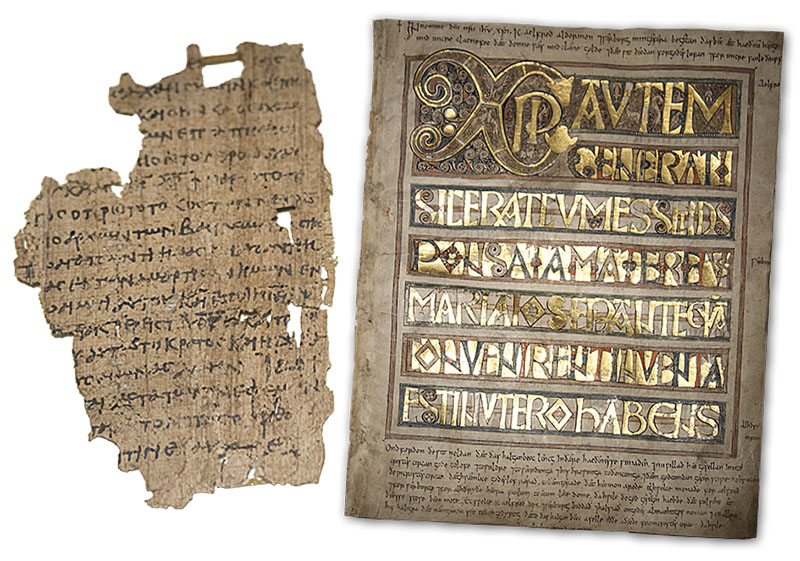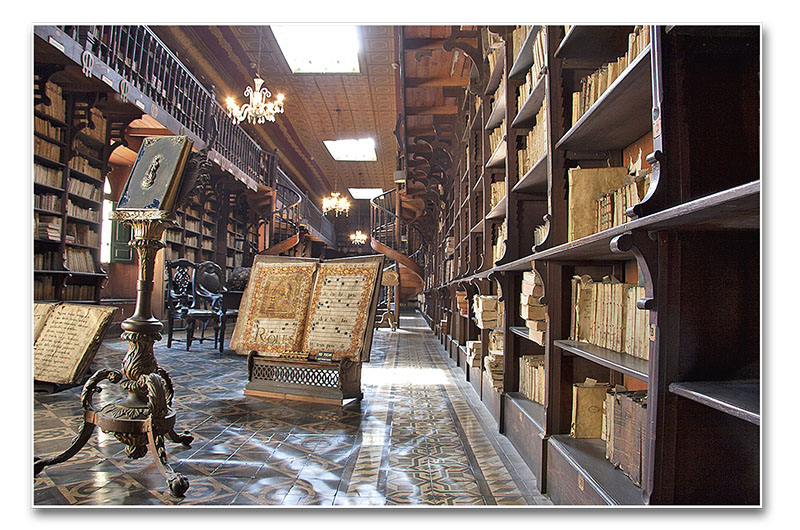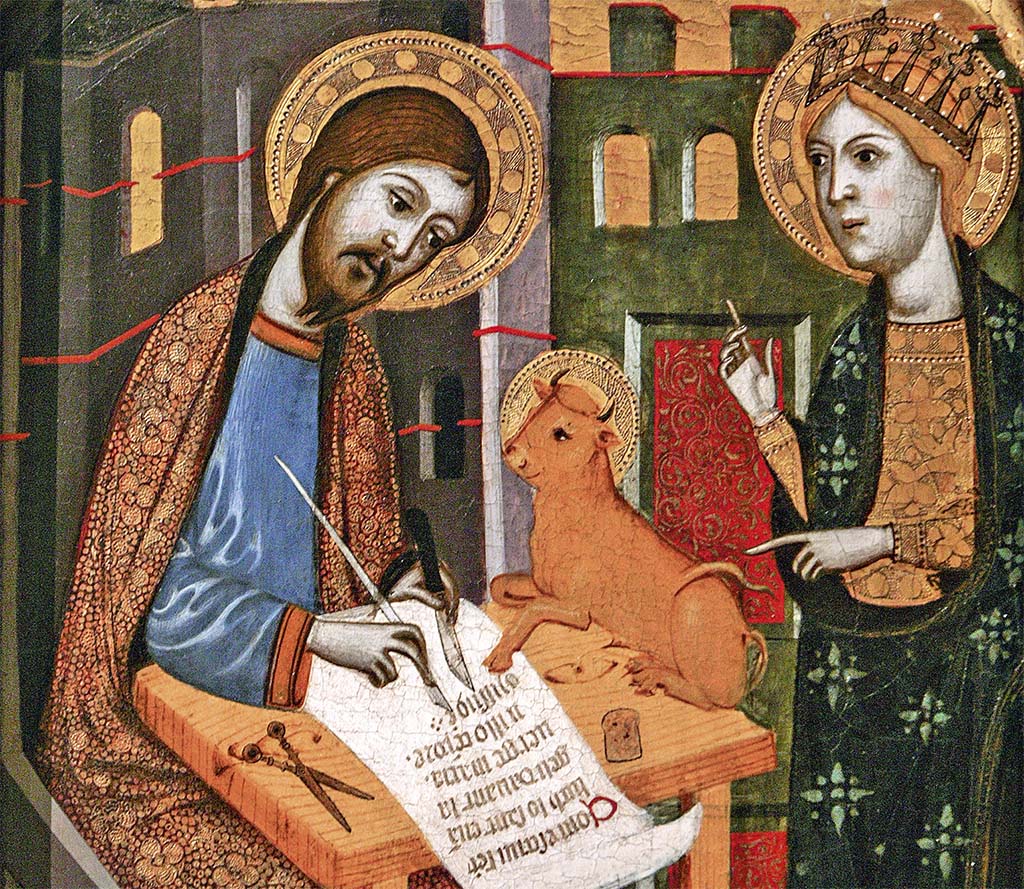In a previous article we discussed the formation of the canon of the Bible; that is, the list of Sacred Books that contain the Word of God, originally transmitted through oral tradition. Conserved, by the action of the Holy Spirit, in the authenticity and integrity of divine teaching, these traditions were later committed to writing by men aided by the charism of inspiration: hagiographers.
The reader is surely interested in knowing when and in what way these writings were produced and how they came down to us. The first question to arise, then, is: were the original texts of the hagiographers conserved? If not, how were they transmitted to successive generations and what are the most important sources for the biblical text that we know today?
At the time in which the books of Sacred Scripture were composed, writing instruments were rudimentary, and the materials used could not have endured the thousands of years that have elapsed between those times and our days. It is, then, readily explainable how the original Bible texts (autographs) and many of their successive copies have been lost, with the exception of some rare fragments.
When was the Bible written?
Today we know that the Bible was written over a span of a little more than thousand years.
It was believed for many centuries that the first and one of the greatest hagiographers was Moses, who was thought to have written the Pentateuch. Therefore, the writing of the Bible would have begun around the year 1200 BC. Today, such a belief is disputed by most experts who, based on subsequent scientific discoveries and careful research, prefer to date the first writings to the time of Solomon, approximately 1000 BC.
The fact that the New Testament refers, at times, to Moses as the author of these books1 does not present a difficulty, since we know that it was not the intention of the hagiographers—nor, above all, of the Holy Spirit—to transmit precise scientific or historical knowledge through Sacred Scripture, but rather the truths that are relevant to our salvation. Hagiographers, therefore, express themselves on these subjects according to the commonly held conceptions of the time.
Similarly, it is generally believed today that the first Old Testament writings were not those of the Pentateuch, but of some of the historical books. Many scholars even believe that the first written text was the canticle of Deborah, from the Book of Judges.
It is not possible to precisely determine the dates in which the sacred books of the Old Testament were written, but the most widely accepted chronology is that which follows.
Up until the reign of David and Solomon (the years 1000 to 930 BC, approximately), the canticle of Deborah, the books of Samuel and some episodes of Genesis had appeared. In the period stretching from that time until the Babylonian exile (930 to 586 BC) some prophetic books were added: Amos, Hosea Micah, Isaiah (1–39), Jeremiah, Zephaniah, Nahum, Habakkuk and Deuteronomy. The books of Ezekiel, the second part of Isaiah, the so-called Deutero-Isaiah (40–55), Joshua, Judges and Kings were from the time of the exile (586 to 538 BC).
In the first post-exile period (583 to 300 BC) the books of Haggai, Zechariah, the third part of Isaiah—the Trito-Isaiah—(56–66), Malachi, Job, Jonas and the Song of Songs emerged; the Psalms were also concluded, Proverbs were expanded and Ezra and Numbers appeared. It is only during this epoch that the Pentateuch was completed.
In the second period after the exile (330 to 50 BC), which is the era of the Maccabees, the books of Tobit, Ecclesiastes, Sirach and Wisdom appeared. And finally, in the century preceding the nativity of Jesus Christ, the final books emerged: Joel, Daniel, Judith, and the first and second book of Maccabees.
The New Testament books were probably written between 50 and 100 of the Christian Era. And the first were not the Gospels, but some of the Pauline letters.

Papyri and parchments
In the time of the kings of Israel, when presumably the majority of the books of the Old Testament were written, and in apostolic times, in which almost all of those of the New Testament were produced, the typewriter was unknown, not to mention modern computers. There was not even paper and pen! How, then were these texts written?
We are amazed to find that during a certain time in Antiquity, writing was frequently engraved on stone, or on metal or ceramic plates. The latter were clay tablets upon which the actual characters composing the texts were imprinted with a stylus. These tablets were then baked in an oven and thus conserved.
When the biblical books began being written, however, simpler means of writing had already become available—the use of ink on papyrus or parchment, the precursors of paper.
Papyrus came from a plant, found in abundance on the margins of the Nile, its pressed stalk providing something akin to a sheet of paper. The Israelites became familiar with it from the time they had spent in Egypt, and the Egyptians traded in it extensively. Aquatic vessels2 and other objects were also produced with it. The basket in which Moses was placed among the reeds of the river to flee from the wrath of the Pharaoh was made of papyrus.3
Parchment originated in the city of Pergamon, capital of Mysia and an important metropolis of Asia Minor, after which it is named. It is specially treated sheepskin, resulting in a consistent and relatively fine sheet. It is much more resistant and durable than papyrus, but also much more expensive; it came into use for the most important documents.
Books written on papyrus were generally conserved in rolls, kept in the Temple and synagogues, to be read during liturgical ceremonies. Parchments were thicker and were difficult to store in rolls, bringing about the important invention of volumes called codices. A codex was formed by folding the parchment sheets in four, and binding them into volumes similar to our present-day books. This great discovery is perhaps owed to Christians, for codices were in use during the first centuries of Christianity.
What are called Codices today—the oldest extant copies of the Bible—thus date from the first centuries of Christianity. Some of them contain almost complete versions of the Scriptures. The principal ones are found in the Vatican Library, the British Museum, and in some other great museums. Various modern translations have been made from these “originals” of Sacred Writ.
From the Middle Ages, by the meritorious work of the monk copyists, numerous copies of the Scriptures have come down to us. And the most recent archaeological discoveries attest to the admirable fidelity of medieval manuscripts to the oldest versions.
The languages of the Bible
The Hebraic, Aramaic and Greek languages predominated during the eras and in the places in which the biblical texts were written. It was in these languages that the Scriptures were written. In this way, Hebrew, a language of Canaanite origin, was identified with the Hebrews in salvation history, becoming the sacred language of the Chosen People.
With the expansion of Syrian dominion and its numerous incursions into Palestine, culminating in the Babylonian captivity, the Aramaic language became increasingly more widespread. Since the Arameans formed a sort of natural bridge between the Assyrians and the Israelites, their language was used in diplomatic relations between the two peoples. By the time of the Persian hegemony, Aramaic was already the vernacular language in Palestine, and Hebrew had been mostly relegated to liturgical use.
The subsequent conquests of Alexander the Great brought about the predominance of Hellenic culture. Accordingly, Greek gradually replaced Aramaic as the common language, and had become the universal idiom at the dawn of Christianity. The fact that, after the Babylonian exile, many Israelites had remained dispersed throughout foreign lands (the diaspora) where Greek predominated, as well as the pre-eminence that many Gentiles came to give to Jewish Scriptures during this time, necessitated their translation into Greek.
According to long-standing tradition, this task was undertaken in Alexandria by approximately 70 Jewish scholars. Despite working separately, they achieved an identical result, which is why the translation is known as the Septuaginta, or from the Seventy.
During Jesus’ time, Hebrew had fallen out of use among the people; Aramaic was the language most widely used by the Divine Teacher in His preaching. At the beginning of the Christian Era, in the region where Christianity developed, a popular version of Greek, called Koiné, predominated. It was precisely this language that was used in almost all of the first Christian writings. The Old Testament was written in Hebrew and Aramaic, except the book of Wisdom, 2 Maccabees, and some passages from Daniel and Esther, which were in Greek. The New Testament was written in Greek (Koiné). According to some—an opinion largely discredited today—, the Gospel of St. Matthew had been written in Aramaic (or Hebrew), but the only known copies of it are in Greek.

The Vulgate and modern translations
At the request of Pope St. Damasus (366-384), St. Jerome accomplished the translation of Sacred Scripture into Latin in the fourth century. Known by the name of Vulgate (the divulged), it was for many centuries the official Bible text and served as the basis for the translations into the various vernacular languages.
Recently, many specialists have set about the task of translating the Sacred Books directly from the “original” sources, namely, the oldest copies preserved in Hebrew, Aramaic and Greek. From these ancient copies, that is, from the great medieval codices, have come the various modern versions of the Bible.
As a result, there are a wide variety of translations beyond the Vulgate and its revised and amended addition, known as the New Vulgate. Inevitably, there are variations of language among them, even among the Catholic editions approved by the Church. For example, in Brazil the Jerusalem Bible, the Ave Maria edition, the Pastoral Bible of the Brazilian Bishops’ Conference and many others are used. They are, in fact, translations with slight variations in language that reflect the translators’ concern to render the original meaning of the sacred texts in a way that is accessible or suitable for the public that they have in mind.
However, the principal purpose of all the authorized versions—namely, those revised and approved by the Ecclesiastical authority—is the same, and it is always the same Word of God, expressed through the resources of human language.
Codices and fragments
Let us now consider the transmission of Sacred Scripture down through the centuries.
Keeping in mind that the oldest known fragments of Old Testament manuscripts date back to the second century BC, and that the original books were probably written as early as the reign of Solomon, around the tenth century BC, there is a period of 800 years between these first writings and the oldest preserved fragments. This means that the Scriptures have come down to us through a long succession of handwritten copies that are no longer extant.
With regard to the New Testament, the time lapse between the writing of the original autographs and the first partially preserved texts is considerably less. For example, there are fragments of St. John’s Gospel from the second century—which represents an interval of less than 100 years. However, more extensive and almost complete texts only date to the fourth century.
Archaeological discoveries from the nineteenth century and, primarily, the Dead Sea Scrolls, found in 1947, have greatly enriched the collection of documents relating to the Old Testament.
The long journey of the sacred texts that have reached us continues to be a broad and fertile research field for scholars. Yet, those who dedicate themselves to this type of research should understand that it must be carried out in a manner enlightened by faith. The expert who embarks on such studies as a merely scientific endeavor severs the research from a fundamental dimension of reality. Indeed, how can a researcher study, for example, the journey of Tobit to Rages from the house of Gabael, with the obstacles encountered, and the solutions found, without considering Raphael, the Angel who guided him? The “angel” that guides the Word of God is the Holy Spirit.4 His action in salvation history must never be overlooked or underestimated.
The Dead Sea Scrolls
The Old Testament documents prior to the Christian Era are relatively few and very fragmentary, which is our reason for placing special importance on the scriptural texts of the first centuries of Christianity. Of those more ancient texts, the oldest in existence date back to between the second and first centuries BC. The main ones are the small Nash Papyrus, discovered in 1002 in Faiyum, Egypt, containing citations from Exodus and Deuteronomy; and by the Qumran texts.
It was the year 1947 when some antique dealers found old papyrus manuscripts for sale in the markets of Bethlehem, containing biblical texts and commentaries on the sacred books. The texts of Isaiah stood out. It was discovered that these manuscripts had come from the Qumran caves in the region of the Dead Sea. Experts were drawn to this discovery, and research and excavations rapidly increased. It was then confirmed that an archaeological treasure of inestimable value had been found.
This material had been preserved over many centuries due to the atmospheric conditions of the place where they were discovered, for papyrus normally deteriorates rapidly.
“The texts discovered in the Qumran caves itself seem to have constituted the library of a community which was customarily referred to as the monks of Qumran, originating from the sect of the Essenes—priests who did not accept the situation of the Temple in Jerusalem—, described by Flavius Josephus in his ‘Antiquities of the Jews.’”5
These manuscripts deposited in the Qumran caves shortly before the fall of Jerusalem, in the year 70 of our era, were probably hidden by remnants of the aforementioned religious community, because of the mounting danger from the Roman siege. It is presumed that they were copied between the third century BC and first century AD.6 In Qumran, partial copies were found—some are only fragments—of all the biblical books except for the Book of Esther.
The importance of the Qumran manuscripts lies, above all, in the fact that they provided a new outlook for biblical research. Indeed, biblical documents prior to the great medieval manuscripts were very scarce and the oldest text known before 1947 is the previously mentioned Nash Papyrus, which does not contain a complete biblical text as such, but excerpts from the Pentateuch.7 The document wealth of the archaeological collection of Qumran can be appreciated if one considers that its documents are one millennium older than the preserved great medieval manuscripts.

The period of uncial and of cursive writing
Let us now deal with the writing of these ancient books, and above all, of the great medieval manuscripts by means of which the Bible has come down to us. We can divide the history of the ancient texts of Sacred Scripture into two periods: that pertaining to writing in upper case letters, or uncial script, and that of cursive writing.
From the beginning, until about the ninth century BC, scriptural texts were copied in capital letters, written separately, called uncial script, an excessively laborious form of writing. From that time on, so-called cursive writing came into use, with lowercase letters joined together, as is done today. This process greatly facilitated the task of the copyists and bequeathed to us a rich collection of thousands of biblical texts.
What particularly interests us at the moment is the study of the uncial scripts, due to their antiquity and documental importance, as well as for their being used as sources for the modern translations of Sacred Scripture. About 30 uncial manuscripts have come down to us with a more or less ample content of writings from the Old and New Testament, and in varying degrees of preservation.
Before we describe the main uncial codices, we will dedicate a few words to the form of the volumes containing these writings.
We have already seen that, in Antiquity, writing was kept in rolls. As divulgation of the parchments became more widespread, it was difficult to store them this way, as they were considerably thicker than papyrus, prompting the production of codices or volumes. This method consisted in folding the sheets of papyrus or parchment in four and forming books, permitting writing on both sides of the sheet, something impossible with rolls.
This development facilitated the storage and handling of the books, and is considered, for that era, to be an invention as important as that of the printing press in the fifteenth century.8
The use of the codex also aided the apostolate, for it enabled missionaries to easily carry the sacred books in their baggage in just one volume, instead of dozens of rolls.
The Word of God has traversed millennia
For the reader interested in biblical studies, we hope to have offered here a brief synthesis of the rich and broad panorama relating to the literary history of the Bible. In it, we clearly see the faith and the faithfulness of so many men who dedicated themselves to the sublime task of transmitting the Sacred Scriptures to future generations.
We have also glimpsed the meritorious, and at times heroic, efforts of the copyists dedicated to this task. But, what stands out above all is the action of Divine Providence, mysteriously ensuring that the Word of God traverse millennia and come down to us intact. ◊

The Principal Codices
Codex Vaticanus — Kept in the Vatican Library from which it derives its name. It is perhaps the oldest codex—dating from the fourth century—and is also the most important and precious due to its high level of preservation and documental importance. It contains the entire Old Testament starting from Gn 46:28 and all of the New Testament, with the exception of Heb 9:15–13:25, the pastoral letters, Phil and Rev.
Codex Sinaiticus — While also dating from the fourth century, it was only found in the nineteenth century, in Saint Catherine’s Monastery on Mount Sinai—hence its name. It is preserved in the British Museum. It contains the Old Testament with the exception of several missing portions and the entire New Testament. It is the only codex that reproduces the whole New Testament.
Codex Alexandrinus — From the fifth century, it is also kept in the British Museum. Its name is most likely a reference to the city of Alexandria, an important centre of Scriptural studies in Antiquity. It contains the Old Testament with many portions missing, and the New Testament with lacunas in Mt, Jn and 2 Cor.
Codex Ephræmi Rescriptus — Some parchments containing texts from Sacred Scripture were scraped and reused (rescriptus); this particular one was reused for writings of a certain Ephrem (Epfræmi), from which its name is derived. Modern technological means have enabled the extraction of the biblical text, probably from the fifth century. It contains fragments of the Old Testament and the entire New Testament, also very fragmented. It is preserved in the Bibliotèque Nationale of Paris.
Taken from the Heralds of the Gospel magazine, #76.
1 For example, in Rom 10:5.
2 Cf. Is 18:1-2.
3 Cf. Ex 2:3.
4 The Second Vatican Council says the following: “Those divinely revealed realities which are contained and presented in Sacred Scripture have been committed to writing under the inspiration of the Holy Spirit” (Dei Verbum, n.11).
5 KONINGS, Johan. A Bíblia nas suas Origens e Hoje. Petrópolis: 2002, Vozes, p.125. Flavius Josephus, Jewish historian of the first century, and author of the famous Antiquities of the Jews, a history of the Jewish people.
6 BARRERA, Julio Trebolle. A Bíblia judaica e a Bíblia cristã. 2.ed. Petrópolis: 1999, Vozes, p.305.
7 Idem, p.331.
8 Cf. VAN DEN BORN, A., Dicionário Enciclopédico da Bíblia. Petrópolis: 1992, Vozes, v.códice.

